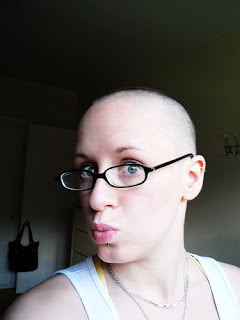Physical Attribute: Head

photo credit: Ocktobre via photopin cc
Physical description of a character can be difficult to
convey—too much will slow the pace or feel 'list-like', while too
little will not allow readers to form a clear mental image. If a reader
cannot imagine what your character looks like, they may have trouble
connecting with them on a personal level, or caring about their plight.
One
way to balance the showing and telling of physical description is to
showcase a few details that really help 'tell the story' about who your
character is and what they've been through up to this point. Think about
what makes them different and interesting. Can a unique feature,
clothing choice or way they carry themselves help to hint at their
personality? Also, consider how they move their body. Using movement
will naturally show a character's physical characteristics, keep the
pace flowing and help to convey their emotions.
HEAD
Descriptors: shaven, bristled, bumpy, bulbous, veined, oval, egg-shaped, pointed, wide, elongated, narrow, dented, smooth, scarred, age-spotted, stumpy, small
Things Heads Do
nod: dip, incline, duck and lift, bow, tip, bob
shake: wag, jerk, waver, sway, rock, tremor
tilt: slant, cock, twist, shift, lean, turn, pitch, bend
Key Emotions and Related Head Gestures:
People often move their head without thinking, especially when interacting with others, so it's a good way to spot a shift in emotion. During conversation, a person may tip their head forward when they are feeling vulnerable (uncertainty, nervousness, fear, shame, embarrassment, confusion, etc.) Rubbing the back of the head can be a self-soothing gesture for worry, anxiety, sadness and dread.
Looking down via a forward head tilt is a common way to conceal an emotional reaction to what is being said or done. A head tilted to the side is a good indication of deep thought--it can mean a person is focused on what's happening or being said, or they are searching for the the right thing to say. People also indicate and motion with their head, using it to draw a person's attention to a specific area.
Simile and Metaphor Help:
Mary's jaw dropped and her head darted side to side like a high powered
ping pong ball. Whatever gossip Karen and Lisa were dishing, it must be good.
Levi hit the switch, and old time country music blasted out the speakers. Professor Stewart jumped out his chair, his liver-spotted head bobbing this way and that--a discarded jack-in-the-box with one last crank left in him.
Clichés to Avoid : Calling a bald man egg-headed or a cue ball
HINT: When
describing any part of the body, try to use cues that show the reader
more than just a physical description. Make your descriptions do double
duty. Example:
Dusty scraped his hands over his bristly head, pacing erratically. As he muttered to himself, glancing at the emergency doors every few steps, I noticed his fingers would linger on the twisted scar just above his right ear before traveling back. My heart squeezed painfully for him. The car accident, of course. He was just a child, too young to remember it, but it left him without parents. What a terrible memory to have surface as he waited for word on his son's condition from the hit and run.
BONUS TIP: The
Colors, Textures & Shapes Thesaurus in our sidebar might help
you find a fresh take on some of the descriptors listed above!

Published on April 13, 2013 03:30
No comments have been added yet.
Writers Helping Writers
A place for writers to find support, helpful articles on writing craft, and an array of unique (and free!) writing tools you can't find elsewhere. We are known far and wide for our "Descriptive Thesau
A place for writers to find support, helpful articles on writing craft, and an array of unique (and free!) writing tools you can't find elsewhere. We are known far and wide for our "Descriptive Thesaurus Collections" which help authors create vivid imagery and sensory detail for their Settings, Characters (physical descriptions, emotions, skills & talents, etc.), Symbolism, Weather, and a whole bunch more. Stop in and say hello! :) http://writershelpingwriters.net/
...more
- Angela Ackerman's profile
- 1023 followers



